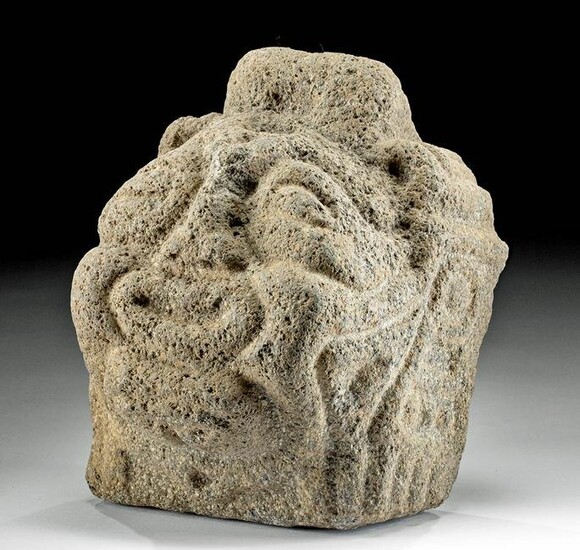Maya Stone Head - Ik' K'uh (Wind Deity)
**Originally Listed At $1500**
Pre-Columbian, Southern Mexico to Guatemala, Maya, Late Classic Period, ca. 550 to 900 CE. A hand carved anthropomorphic stone of the Maya wind deity, Ik' K'uh, comprised of exaggerated facial features to emphasize his aspects. The piece is a head fragment from a larger statue, the flat sides are etched with large ear spools and ornaments, and atop the brow is a headdress. The visage is very jowly- a thick chin engraved with a T shape, under puckered lips and dimpled, fleshy cheeks under almond shaped eyes set next to a broad nose. The "T" is an important indicator of the deity, for this is the Maya symbol for wind or breath- and this visage looks like the cheeks are full of air to expel as a wind gust. Size: 9" L x 9" W x 12" H (22.9 cm x 22.9 cm x 30.5 cm)
The "T" is the symbol for the Mayan word "ik" meaning both wind and breath, but also had other more ambiguous meanings. Ik' K'uh is the wind and music deity that embodied the breath or spirit, which sustains the gods and invigorates their spiritual force. Breath and breathing marked the difference between life and death. Despite being a destructive force of nature, wind was also life affirming aspect. Wind instruments were important part of ritual use in Maya culture, drawing a connection between human breath, the energy force, creating sound, or giving life to an otherwise intimate object. Ik' K'uh was likely the predecessor to Ehecatl, the wind deity of the Aztecs. Ehecatl - a form of Quetzalcoatl - "Feathered Serpent" in the Nahuatl language - is the Pre-Columbian deity revered as the lord of air and sky. The earliest representations of Quetzalcoatl adorn the Temple of Quetzalcoatl in Teotihuacan, Mexico (ca. 3rd century CE) where numerous stone heads of the divine plumed snake embellish the steps of this Pre-Classic pyramid. The Aztecs believed Ehecatl was an aspect of Quetzalcoatl, and Ehecatl-Quetzalcoatl was associated with wind and creation.
Provenance: private Hidden Valley Lake, California, USA collection; ex-San Diego, California, USA collection, from the 1960s
All items legal to buy/sell under U.S. Statute covering cultural patrimony Code 2600, CHAPTER 14, and are guaranteed to be as described or your money back.
A Certificate of Authenticity will accompany all winning bids.
We ship worldwide to most countries and handle all shipping in-house for your convenience.
#170518
Condition Report: Fragment of a larger piece as shown. Loss and abrasion to nose. Softening to details, but visage is discernable. Chips and nicks throughout. Naturally porous surface with light mineral and earthen deposits. Overall excellent condition.
View it on
Sale price
Estimate
Time, Location
Auction House
**Originally Listed At $1500**
Pre-Columbian, Southern Mexico to Guatemala, Maya, Late Classic Period, ca. 550 to 900 CE. A hand carved anthropomorphic stone of the Maya wind deity, Ik' K'uh, comprised of exaggerated facial features to emphasize his aspects. The piece is a head fragment from a larger statue, the flat sides are etched with large ear spools and ornaments, and atop the brow is a headdress. The visage is very jowly- a thick chin engraved with a T shape, under puckered lips and dimpled, fleshy cheeks under almond shaped eyes set next to a broad nose. The "T" is an important indicator of the deity, for this is the Maya symbol for wind or breath- and this visage looks like the cheeks are full of air to expel as a wind gust. Size: 9" L x 9" W x 12" H (22.9 cm x 22.9 cm x 30.5 cm)
The "T" is the symbol for the Mayan word "ik" meaning both wind and breath, but also had other more ambiguous meanings. Ik' K'uh is the wind and music deity that embodied the breath or spirit, which sustains the gods and invigorates their spiritual force. Breath and breathing marked the difference between life and death. Despite being a destructive force of nature, wind was also life affirming aspect. Wind instruments were important part of ritual use in Maya culture, drawing a connection between human breath, the energy force, creating sound, or giving life to an otherwise intimate object. Ik' K'uh was likely the predecessor to Ehecatl, the wind deity of the Aztecs. Ehecatl - a form of Quetzalcoatl - "Feathered Serpent" in the Nahuatl language - is the Pre-Columbian deity revered as the lord of air and sky. The earliest representations of Quetzalcoatl adorn the Temple of Quetzalcoatl in Teotihuacan, Mexico (ca. 3rd century CE) where numerous stone heads of the divine plumed snake embellish the steps of this Pre-Classic pyramid. The Aztecs believed Ehecatl was an aspect of Quetzalcoatl, and Ehecatl-Quetzalcoatl was associated with wind and creation.
Provenance: private Hidden Valley Lake, California, USA collection; ex-San Diego, California, USA collection, from the 1960s
All items legal to buy/sell under U.S. Statute covering cultural patrimony Code 2600, CHAPTER 14, and are guaranteed to be as described or your money back.
A Certificate of Authenticity will accompany all winning bids.
We ship worldwide to most countries and handle all shipping in-house for your convenience.
#170518
Condition Report: Fragment of a larger piece as shown. Loss and abrasion to nose. Softening to details, but visage is discernable. Chips and nicks throughout. Naturally porous surface with light mineral and earthen deposits. Overall excellent condition.



